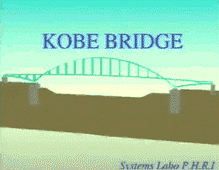RESEARCH
"Logic is the foundation of the certainty of all the knowledge we acquire." -Leonhard Euler
"It is not knowledge, but the act of learning, not possession, but the act of getting there, which grants the greatest enjoyment." -Carl Friedrich Gauss
Damage estimation of soil-structure systems during large earthquakes
More than 6000 people were killed, and destructive damage on infrastructures, such as lifelines, bridges, and port facilities, was triggered by the 1995 Hyogo-ken-Nanbu, Japan, Earthquake. Among these damaged infrastructures, soil-structure systems, such as wharves and/or bank protection around reclaimed land and river dykes, suffered catastrophic damage mainly due to soil liquefaction. The damage was also severe in terms of the restoration period and its cost. Therefore it became socially imperative to estimate the degree of damage on these structures after earthquakes with higher accuracy.
To analyze and estimate the damage, the computer program called FLIP ROSE has been developed. The FLIP ROSE is a FEM program for the effective stress analysis with multiple shear mechanism of sands. It has been used to analyze and estimate the degree of damage to various infrastructures. As examples, the figures below show a result of the analysis for the Kobe Bridge, which suffered severe damage during the Hyogo-ken-Nanbu Earthquake, and a simulation result of the behavior of a gravity type quay wall in centrifuge model tests, respectively (red color indicates high excess pore water pressure in both figures).

Improvement of a constitutive model of soils based on the concept of multiple shear mechanism
In order to precisely predict the damage of soil-structure systems during earthquakes, it is necessary to appropriately represent the dynamic behavior of geotechnical materials from small strain range to the non-linear region including liquefaction in numerical simulation. We have proposed a constitutive model of soils (called Cocktail Glass Model) as a mechanical model for granular materials such as sands based on the concept of multiple shear mechanism. This model originates from interpreting soils as granular materials, which are composed of masses of soil particles, and is capable of expressing the changes in the internal structure due to the contact force between the particles.
By plotting the dilative component of dilatancy and the virtual simple shear strain on the vertical and horizontal axes, respectively, in the Cocktail Glass Model, a flower of butterfly shape shown in the figure below appears like the structure of stress-induced anisotropy for an assembly of soil grains. This model, which has been incorporated
into the above-mentioned numerical analysis program (FLIP ROSE), can take into account the effect of dilatancy characteristic of granular materials and its related induced anisotropy appropriately.
Towards the improvement of numerical simulation, we have also extended the above-mentioned strain space multiple shear mechanism model based on the finite strain theory and developed a large deformation analysis program (called FLIP TULIP) for soil-structure systems incorporating the extended model. In the program, both the Total Lagrangian (TL) and Updated Lagrangian (UL) formulations are available.

Study on the deformation mechanism of soil-structure systems due to long-duration earthquakes and tsunami
During the 2011 off the Pacific coast of Tohoku Earthquake, a structure made of reinforced concrete having a pile foundation collapsed due to tsunami. In this case, the liquefaction of ground has been considered to accentuate the damage in combination with the tsunami wave force. In the case of a bay mouth breakwater, the possibility of a complex disaster caused by earthquake and tsunami - the failure of the breakwater due to the effect of seepage flow through the rubble mound due to water head difference due to tsunami in combination with the wave force action - has been pointed out.
Thus, we performed a series of centrifuge model tests for a caisson-type quay wall on a rubble mound by using a special container for simulating tsunami in the centrifugal field in order to clarify the complex failure mechanism of breakwaters due to tsunami, as shown in the right figure. The results have demonstrated the importance of the mechanism of failure in the rubble mound due to the seepage flow of pore water in addition to the wave force of tsunami action. In particular, the results without the seepage flow by artificially covering the side of the oncoming wave using rubber membrane have revealed that there might have been no damage or only slight damage to the breakwater without the effect of seepage flow in the rubble mound.
Liquefaction Experiments and Analysis Projects
Individual research institutes have researched geo-hazards' predictions, such as liquefaction in conjunction with individual projects using separate experimental facilities and numerical analysis methods. Such an approach ensures the consistency and reproducibility of the results within a single institution. Still, there has been no examination of the results' universality and objectivity in terms of consistency and reproducibility if other institutions were to work on the same subject.

To break through the limitations of conventional research approaches, an international project, LEAP (Liquefaction Experiments and Analysis Projects), was launched to ensure the universality of results and improve the accuracy of predicting geo-hazards through simultaneous experiments using a centrifuge and analyses using various constitutive models. In addition to us, the participants in this project include the University of California, Davis, Rensselaer Polytechnic Institute, George Washington University (USA), University of Cambridge (UK), Zhejiang University (China), and National Central University (Taiwan).